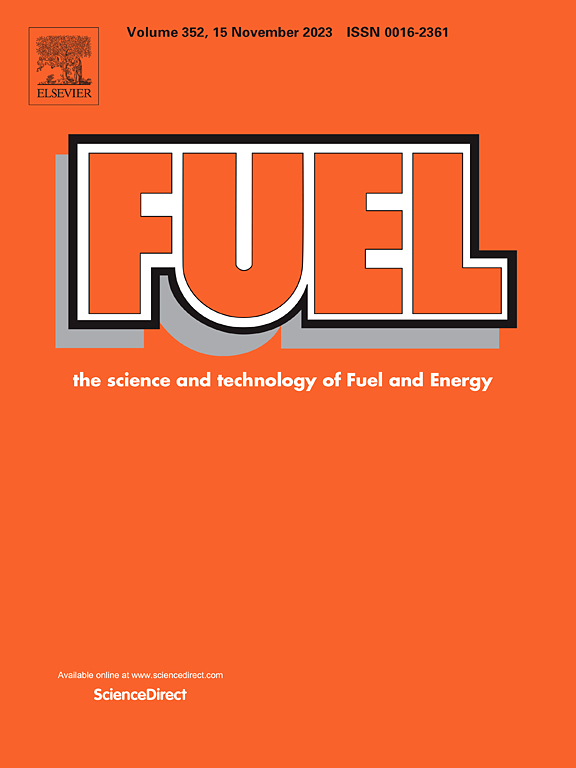External fuel reforming for compression-ignition engines
IF 6.7
1区 工程技术
Q2 ENERGY & FUELS
引用次数: 0
Abstract
This paper presents the results of a study on the reduction of toxic exhaust gas emissions from compression-ignition engines by applying a fuel pretreatment. This treatment consists of contacting the fuel with a heterogeneous catalyst in the form of a Cu-Ni alloy applied to the nozzle needle in the fuel injector body. In this case, the pre-treatment of the fuel allows the fuel to reform. As determined in laboratory tests, fuel reforming is presented by an increase in the proportion of the olefin group in the atomised fuel and a decrease in the proportion of the paraffin group, which may indicate the occurrence of a fuel dehydrogenation reaction and the release of free hydrogen on contact with the catalyst. To apply the heterogeneous catalyst by electrospray fusion, the passive part of the atomiser needle was used, connecting the needle’s precision surfaces (its guide and firing cone). Laboratory tests of the atomiser modified in this way showed a change in the hydrocarbon groups of the fuel after contact with the catalyst. Results from bench tests of an experimental compression-ignition engine equipped with a pre-treated fuel injector showed a reduction in nitrogen oxide emissions of up to 30 %. Analysis of the engine process indicator diagrams shows that the achievement of such results is related to the reforming of the fuel, which leads to a reduction in the maximum pressure and heat release values, resulting in a reduction in the combustion temperature in the kinetic phase of the combustion process, responsible for the formation of nitrogen oxides in the engine cylinder. The applied electro-spark alloying method for the deposition of Cu-Ni catalysts on the passive part of the injector nozzle’s needle does not cause thermal distortion of the precision pair of the fuel injector and can be recommended for use both in the production process of injection equipment for compression-ignition engines and during their operation.
压缩点火发动机的外部燃料重整
本文介绍了采用燃料预处理技术减少压燃发动机有毒废气排放的研究结果。这种处理方法包括用一种Cu-Ni合金形式的多相催化剂接触燃料,这种催化剂应用于喷油器体内的喷嘴针。在这种情况下,燃料的预处理允许燃料重整。在实验室试验中确定,燃料重整表现为雾化燃料中烯烃基团比例的增加和石蜡基团比例的减少,这可能表明发生了燃料脱氢反应和与催化剂接触时释放出自由氢。采用电喷雾熔敷多相催化剂时,使用了雾化器针的被动部分,连接针的精密表面(导针和射锥)。用这种方法改进的雾化器的实验室测试表明,在与催化剂接触后,燃料的碳氢化合物基团发生了变化。一台装有预处理喷油器的实验性压缩点火发动机的台架测试结果表明,氮氧化物排放量减少了30%。通过对发动机工艺指标图的分析可知,这一结果的产生与燃料的重整有关,燃料的重整导致最大压力值和放热值的降低,从而导致燃烧过程动力学阶段的燃烧温度降低,从而导致发动机气缸内氮氧化物的形成。应用电火花合金化方法在喷油器针的被动部分沉积Cu-Ni催化剂,不会引起喷油器精密副的热变形,可推荐用于压燃式发动机喷射设备的生产过程和使用过程。
本文章由计算机程序翻译,如有差异,请以英文原文为准。
求助全文
约1分钟内获得全文
求助全文
来源期刊

Fuel
工程技术-工程:化工
CiteScore
12.80
自引率
20.30%
发文量
3506
审稿时长
64 days
期刊介绍:
The exploration of energy sources remains a critical matter of study. For the past nine decades, fuel has consistently held the forefront in primary research efforts within the field of energy science. This area of investigation encompasses a wide range of subjects, with a particular emphasis on emerging concerns like environmental factors and pollution.
 求助内容:
求助内容: 应助结果提醒方式:
应助结果提醒方式:


